Nicole Robb
Technical Summary

During an infection, a virus enters a cell, disassembles into functional components, and harnesses the cellular machinery to produce multiple copies of itself; these new copies then spread to neighbouring cells. Much of our knowledge of this process relies on data obtained using ensemble methods that report on the averaged properties of millions of molecules. However, using single-molecule techniques, we can now measure the structural and functional properties of single replication complexes in real-time, revealing unique details that may be difficult to see using traditional biology or biochemistry methods.
We use in-vitro single-molecule assays like Förster resonance energy transfer (FRET) to investigate the mechanisms of replication (RNA binding, initiation, elongation and termination) of viruses like influenza, SARS-CoV-2 and Bluetongue virus. We also study the morphology and cellular interactions of influenza viruses using super-resolution fluorescence microscopy techniques such as dSTORM, PALM and single-molecule FISH. Understanding the interactions between viruses and the infected cell is vital to combating viral disease.
The rapid and accurate identification of viral pathogens is needed to help prevent transmission, set up appropriate therapy, monitor response to treatment and lead to efficient disease management and control. We develop rapid and sensitive fluorescence-based diagnostic assays to identify RNA viruses in complex biological samples, combined with machine learning algorithms for data analysis.
Selected publications:
1) Robb, N.C., Taylor, J.M., Kent, K., Pambos, O., Gilboa, B., Kapanidis, A.N. (2019) Rapid functionalisation and detection of viruses via a novel Ca2+-mediated virus-DNA interaction. Scientific Reports. 9(1):16219. https://doi.org/10.1038/s41598-019-52759-5
2) Robb, N.C., te Velthuis, A.J.W., Fodor, E., Kapanidis, A.N. (2019) Real-time analysis of single influenza virus replication complexes reveals large promoter-dependent differences in initiation dynamics. Nucleic Acids Research. 47(12):6466-6477. https://doi.org/10.1093/nar/gkz313
3) Hellenkamp, B., Schmid, S., et al. (2018) Precision and accuracy of single-molecule FRET measurements - a multi-laboratory benchmark study. Nature Methods. 15(9):669-676. https://doi.org/10.1038/s41592-018-0085-0
4) Robb, N.C., te Velthuis, A.J.W., Wieneke, R., Tampè, R., Cordes, T., Fodor, E. and Kapanidis, A.N. (2016) Single-molecule FRET reveals the pre-initiation and initiation conformations of influenza virus promoter RNA. Nucleic Acids Research. 1;44(21):10304-10315. https://doi.org/10.1093/nar/gkw884
5) Te Velthuis, A.J.W., Robb, N.C., Kapanidis, A.N. and Fodor, E. (2016) The role of the priming loop in Influenza A virus RNA synthesis. Nature Microbiology. 1:16029. https://doi.org/10.1038/nmicrobiol.2016.29
6) Tomescu, A.I., Robb, N.C., Hengrung, N., Fodor, E. and Kapanidis, A.N. (2014) Single-molecule FRET reveals the corkscrew RNA structure for the polymerase-bound influenza virus promoter. PNAS. 111(32):E3335-42. https://doi.org/10.1073/pnas.1406056111

